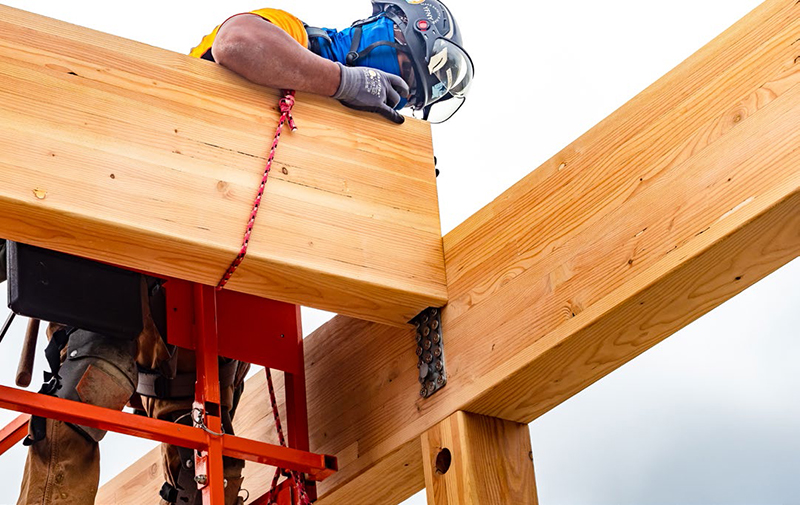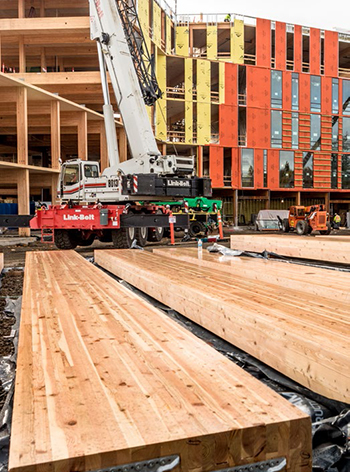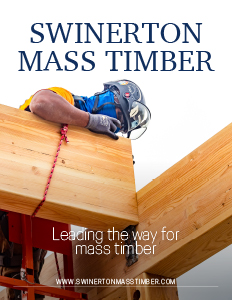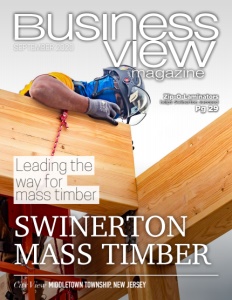Swinerton Mass Timber
Leading the way for mass timber
Business View Magazine interviews Chris Evans, Swinerton Mass Timber’s Director, as part of our focus on the mass timber sector in North America.
Swinerton Mass Timber is a division of Swinerton, Inc., a commercial construction firm and one of the nation’s top general contractors. Their core markets in United States include commercial office, retail, multi-family residential, hospitality, healthcare, education, energy, and the entertainment sectors. Headquartered in San Francisco, California, Swinerton was founded in 1888 by Charles Lindgren who partnered with Lewis Hicks, a civil engineer who pioneered the innovation of steel-reinforced concrete in buildings. During the construction of the Fairmont Hotel in San Francisco, the Great Earthquake & Fire of 1906 occurred and one of the few buildings to survive was the Fairmont Hotel. Swinerton also built San Francisco’s Ghirardelli Square, as well as one of the first green buildings in the nation, the Weyerhaeuser Headquarters in Federal Way, Washington.
Headquartered in Portland, Oregon, Swinerton Mass Timber provides turnkey mass timber structures to the U.S. commercial construction market, working as a specialty trade partner for both Swinerton and other general contractors. Mass timber is a term used to describe a number of large engineered wood products that typically involve the lamination and compression of multiple layers to create solid panels of wood. Mass timber construction uses those panels to frame a building’s walls, floors, and roofs and is seen as a sustainable and more carbon-friendly alternative to steel and concrete.
“In late 2016, early 2017, we started to do internal research on the mass timber market,” explains Chris Evans, Swinerton Mass Timber’s Director. At that time, Swinerton was building the country’s largest cross-laminated timber structure in Hillsboro, Oregon – the First Tech Federal Credit Union. “We determined that mass timber structures in commercial construction wasn’t going to be a niche, but that it would take a significant market share, moving forward, and be a viable structural system that developers, architects, and everybody involved in the construction process would appreciate and like. So, we started our own group focused on bringing mass timber projects to life in the commercial construction market across the U.S.”
“Our group has roughly 25 administrative staff ranging from detailers and superintendents to project managers and structural engineers,” Evans continues. “We focus on optimizing design and facilitating efficient procurement to make these projects viable. We have projects in varies stages of procurement and construction throughout the country.”
Regarding the company’s clients, Evans says there are three main types: “The first is the private developer that’s looking at either residential or office development; the second type is a build-to-suit type of corporate client, who’s building out a campus or facility and is going to be the ultimate occupant of the building; the third is the public/civic type, i.e. projects in the public realm – municipalities, universities, etc. So, we see a good mix between all three of those types of owners.”
 Since mass timber is still a relatively new construction method in North America (although there have been mass timber buildings in Europe for at least 30 years), Evans says that the company’s main competition does not come from other builders, but rather from other structural systems, mainly pre-cast concrete, reinforced concrete, and structural steel. Thus, their mission is to make mass timber construction achievable, viable, and cost-competitive by looking at a building’s whole costs and finding where the benefits outweigh those of the more traditional structural systems.
Since mass timber is still a relatively new construction method in North America (although there have been mass timber buildings in Europe for at least 30 years), Evans says that the company’s main competition does not come from other builders, but rather from other structural systems, mainly pre-cast concrete, reinforced concrete, and structural steel. Thus, their mission is to make mass timber construction achievable, viable, and cost-competitive by looking at a building’s whole costs and finding where the benefits outweigh those of the more traditional structural systems.
“The industry, in general, has really progressed in the past three years,” Evans notes. “Today, the general ownership population understands what mass timber is and now they’re looking at how to make it viable. So, right now, we’re focused less on trying to explain what a mass timber approach is, and more time on assessing the viability of it. We have a General Contractor’s roots and we understand how the whole building works; how fire-rated partitions work; how the exterior enclosure works; how concrete and foundations work. So, when we’re evaluating a mass timber structure, we’re really showing how it can be integrated into those other systems, what cost-saving ideas are integrating into those other systems, and really sharing that with the client, dispelling any concerns they may have with what the unknowns are. Because we are a GC at heart, we understand the neighboring systems, how they are impacted, and how to solve those types of problems. We are a unique partner on a project because we understand the whole building, not just the timber component.”
When comparing costs to other structural types, Evans explains that there are five major considerations: shipping costs, exchange rate risk, commodity pricing risk, the regional pricing of comparable structural systems, and the cost analysis of building a lighter weight building with a mass timber structure. Shipping pricing is dependent upon the selected manufacturer and distance required to ship the product to the project site. Exchange rate risk affects European and Canadian supplied product, while commodity pricing affects all timber supply. Regional pricing for structural steel and concrete vary across the US, so fully understanding the regional cost of the mass timber building and comparable systems is important.
 Evans states that “it is important not to overlook the cost savings to neighboring systems. A mass timber structure is lighter than concrete and steel structures, saving time and money with ground improvements and foundation work. Those benefits need to be realized in the cost model. Also, the schedule for a mass timber building is quicker by a minimum of 15 percent for most structures, meaning there is savings for the general contractor’s site management team.”
Evans states that “it is important not to overlook the cost savings to neighboring systems. A mass timber structure is lighter than concrete and steel structures, saving time and money with ground improvements and foundation work. Those benefits need to be realized in the cost model. Also, the schedule for a mass timber building is quicker by a minimum of 15 percent for most structures, meaning there is savings for the general contractor’s site management team.”
“There are certain markets where the conditions are really ripe for mass timber to be cost advantageous, and then there are others where it might be a slight cost increase,” Evans admits. “When we’re evaluating mass timber, we’re looking at a whole building approach. Whether we’re the General Contractor on the project or a subcontractor, we’re bringing to the table GC-level sophistication as a partner who evaluates risk, similarly. We’re giving feedback on whether it’s achievable or not while considering a holistic project approach.”
However, even if it becomes evident that the upfront costs of a mass timber building may be more than a traditional one, Evans believes that the ultimate return on the structure can actually turn out to be substantially more for a mass timber structure versus a conventional one. “One differentiator is exposed wood,” he avers, “People just really like to work in a natural environment. A private developer, trying to attract a tenant to their building, may experience quicker absorption because their product differs from what is generally available in the market. They may lock in longer lease periods and achieve a higher rate of return.”
“It’s like when you buy a car,” he claims. “There are certain cars that feel better to be in than others. It’s partly aesthetics, it’s partly performance, it’s partly the comfort that you feel in the space. So, when you’re in a cold, grey shell, you get one feeling, and when you’re in a warm wood environment, you get another sense of being. That’s probably the ultimate thing. When we went full tilt into this business, the number one driving factor, for me, at least, was that being in one of these buildings feels different than being in an office building with dropped acoustic ceiling tiles. It’s two totally different experiences. In the one experience, I want to be there. I’ve had an owner come into a building that we built and just sit on the couch and hang out. They just liked being there. The feel of that interior environment makes a huge difference and I think part of it is a powerful subconscious response. Companies looking at retaining employees or attracting talent are focused on how to make the work experience that they offer beneficial and enjoyable. Exposed mass timber speaks to that higher level of satisfaction. It can lead to better employee performance and a lower attrition rate.”
Intangible experiences notwithstanding, Swinerton Mass Timber is still a business and tangible progress is always on the agenda. Currently, Evans reports that the company is in the process of bringing a Glulam fabrication facility online. Glulam is a type of structurally-engineered, mass timber product constituted by layers of dimensional lumber bonded together with durable, moisture-resistant structural adhesives. “By us being able to have that ability in-house – it helps bring more Glulam manufacturers into the commercial mass timber industry,” he states. “You can build a mass timber building by cutting everything onsite, but that’s not what our definition of a mass timber building is. Our definition is that a mass timber building is a prefabricated kit apart; it has all the hardware on the beams and columns; it clicks together quickly onsite; it has pre-cut holes for all mechanical, electrical, and plumbing, which leads to shorter construction times and enhanced efficiency onsite. With that type of definition, we felt it was really pertinent to open a fabrication facility that allows us to process large Glulam efficiently.”
Long-term, Evans says that his objective is to continue the company’s leadership role in the mass timber industry. “Our mission is simple,” he declares. “We are out to accelerate the mainstream adoption of mass timber construction in the U.S. commercial construction market. To do that, we have to be innovative; we have to find solutions that cut down on labor costs, manufacturing costs, and supply costs, so we can get to that point where in all markets, it’s a cost-competitive structural system that any building owner should consider. That’s our goal. Everything that we’re doing is to support, promote, and grow mass timber in commercial construction.”
AT A GLANCE
WHO: Swinerton Mass Timber
WHAT: A division of Swinerton, Inc., a commercial construction firm
WHERE: Portland, Oregon
WEBSITE: www.swinertonmasstimber.com
PREFERRED VENDORS
Zip-O-Laminators, LLC – www.zipolaminators.com
Custom Glulams – The Relationship Business
Zip-O-Laminators started in 2016 as the newest division of Zip-O-Log Mills, which was founded by the Hallstrom family in 1944 near Coburg, Oregon. The culture of Zip-O has remained consistent for over 75 years: to produce high quality products and exceptional service. Whether it is for a custom timber frame home or a custom golf course club house, every project is unique and we will take care of you!
Zip-O-Laminators is geared towards producing only the highest quality laminated beams in exceptional sizes. Zip-O-Lam can produce beams up to 115 feet long, 28 inches wide and 96 inches deep. We also make custom curves – slight to tight radius beams. Think it cannot be done? Guess again! Certified through the A.P.A – The Engineered Wood Association, we currently produce beams out of Douglas fir and Alaskan Yellow Cedar.
We are certified with the FSC® (Forest Stewardship Council®) and can provide glulams for your next FSC® (FSC® C157387) job.
At Zip-O-Laminators, we have the capacity to produce, fabricate and finish your custom beams.
Types of Fabrication and Finishes:
- Kerfs and Notches
- Holes, Daps and Slots
- Bevel and Taper Cuts
- 14” & 16” single face boards
- Premium Finish
- Resawn Finish
- Sanded Finish
In the world of construction, delays are costly. The entire operation at Zip-O-Laminators is committed to deliver your beams on time. From administration to sales to production to shipment our goal is to provide premium service at every level. Zip-O-Lam can also produce their own lamstock by working with Zip-O-Log Mills, unlike other manufacturers.
We own and operate our own kilns so we can control the quality and moisture content of our stock. We strive for on-time, accurate deliveries by rail or truck. We offer additional shipping options, such as individual, bundle or load wrap, and sticker every layer in the unit with lath or kiln stickers upon request. Additionally, we have all our trucks place corner protectors on their loads as added protection for your beams.
Our ambition is to have your experience with us a breeze and to make your dream a reality. Give us the opportunity to prove it to you.
Dr Johnson Wood Innovations – drjwoodinnovations.com
Family-owned and operated, DR Johnson Wood Innovations paved the way for Mass Timber construction by becoming the First Certified Manufacturer of Cross-Laminated Timber in the U.S. DRJ is committed to providing quality, sustainable manufactured wood products, including Cross-Laminated Timber and custom Glue-Laminated Beams – made from locally sourced materials and engineered to create a faster, more efficient means of construction.





